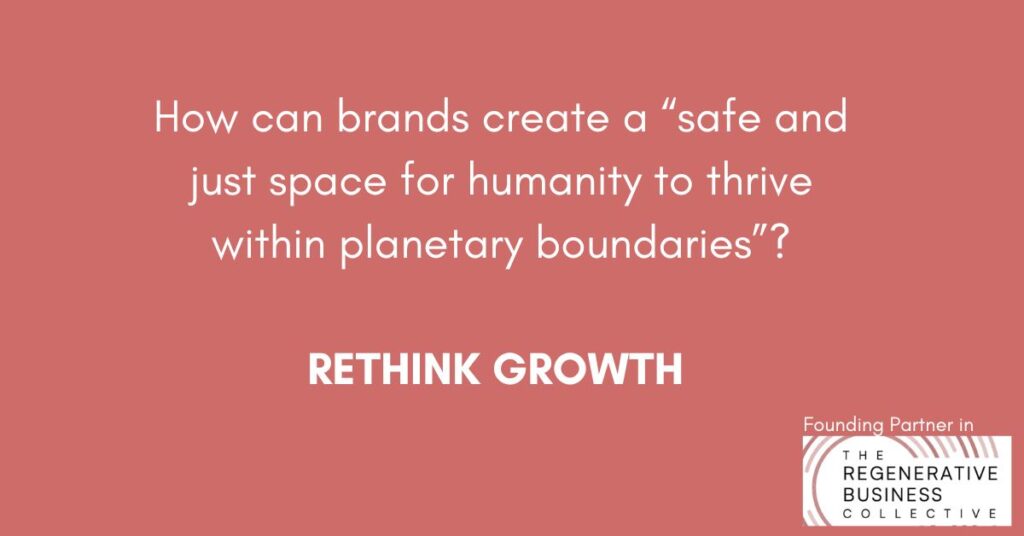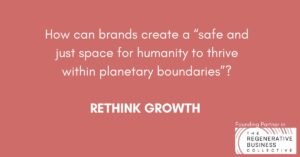It was only 5 years ago that various bodies across Europe, UK, US and Australia redefined the purpose of a company from a focus on delivering profits for shareholders to creating long-term sustainable value for all stakeholders.
Around the same time, New Zealand was in the press for its Wellbeing Budget, ex-Unilever Paul Polman and Andrew Winston published Net Positive: How Courageous Companies Thrive By Giving More Than They Take1, Doughnut Economics2, Circular Economy3 and Wellbeing Economy4 gained traction as potential solutions to recover from the global Covid crisis.
Each in their own way, they sought the attention of government and business leaders to look at growth in a different way, reframing growth in people, planet and prosperity rather than a single measure of GDP or profit.
Before leaders truly grasp those concepts, the next wave of redefining growth – zero growth, post growth and degrowth – has been filling our feeds whilst fuelling the fears of loss of profit, loss of aspiration and loss of functional purpose.
When growth is your remit, what do you do?
At the same time, the ethics in doing business and impact of business on society has shifted from CSR and ESG to Sustainability and Regeneration.
Sustainability considers the material risks as well as the opportunities to create long-term value for all stakeholders across key areas of people, planet and prosperity, aligned to SDGs. Regeneration goes beyond sustainability seeking opportunities for renewal, restoration and regrowth to put more back in for greater socio-economic impact.
The opportunity is for leaders to rethink growth as sustainable and regenerative – both of which provide opportunities for profit, aspiration and functional purpose for the business and individual, whilst caring about broader people and planet needs, shifting from short termism to long term, eliminating excess (consumption, working hours, waste) and putting more back in than you take out.
Some of the leading marketing thinking on growing brands is inherently more sustainable – focussing on long-term brand building rather than short term activation (The Long and The Short of It, Binet and Field5) and continuously attracting new customers to maintain and grow market share rather than selling more to current customers (How Brands Grow, Sharp6) – as is good marketing practice – such as having a clear and coherent range strategy that includes range rationalisation to reduce waste, as opposed to reduced obsolescence which creates more consumption and more waste.
Looking to modern economics thinking, I personally like the Doughnut Economics concept because it helps us think about opportunities where brands can create “a safe and just space for humanity to thrive within planetary boundaries.” That can form a lens for your positioning, brand experience, innovation or communications.
Even having a batch of questions to reconsider your brand plans to curtail excess can open the doors to more opportunities: “Do people need this much?” “Do people need this at all?” and “What could I offer them that really creates value?”.
If sustainability or regeneration is already integrated in your business to a point where it is the same or better than your competitors or potential partners (JV, M&A etc), you’re on the front foot to rethink growth for your brand. But even if your business is further behind, this offers an opportunity for you to influence the business in its sustainability and regeneration initiatives that help grow the brand.
The World Economic Forum7 states that “… those companies that embrace sustainability as an integral part of their operating model are seeing their value increase. This is not just in terms of profits, but also in higher staff retention and engagement, greater customer loyalty, and improved access to markets and funding… Businesses that fail to shift to a sustainable operating model will see their customer base shrink, fall behind in terms of technology, face tighter regulations, find it harder to compete and struggle when economic conditions are difficult.”
To give you more scope to rethink growth, we’ve offered a handful of potential strategic opportunities applied to the Ansoff Matrix – one of the frameworks that business leaders use to consider different ways to grow their brand.
Market penetration: existing products, existing markets
- Improve sustainability of current products and services to provide attractive benefits for your brand vs competitors. Building on its social platform and purpose to improve body image and celebrate real beauty, Dove has added nature regeneration to its strategy.
- Reframe your brand positioning to give it new meaning and relevance to customers today, like Gumtree has done with circularity or by using the Doughnut Economics concept to think about how your brand can create “a safe and just space for humanity to thrive within planetary boundaries.”
- Replace planned obsolescence with service opportunities for consumers to prolong the life of their product, rather than forcing them to replace their products more often than necessary and commonly used in technology, automobiles and fashion. Levi’s offers their Tailor Shop where you can alter, repair or customize your jeans.
Market development: existing products, new markets
- Growing the category and brand by attracting new customer segments or new geographic markets rather than selling more, more frequently to existing customers. This is fundamental to marketing science on “How Brands Grow” as well as being more sustainable.
- Consider new distribution channels through partners or business models that reach new markets with improved sustainability, direct and indirect – ecommerce or direct-to-consumer, local vs CBD. Proponents of buying local emphasise its environmental and social benefits, for example food is fresher, better for you and lower transport emissions for the food and buyer.
- By offering your products as a service, you have any opportunity to reach new markets as well as providing your existing markets with a sustainable alternative. Rather than selling the hardware, HP Device-as-a-Service (DaaS) leases devices to businesses which HP maintains, upgrades, and recycles at the end of their lifecycle.
- Start a buy-back service to reduce waste and resell as secondhand, like Apple has done with their Trade in and Certified Refurbished initiatives.
Product development: new products, existing markets
- Premiumisation: trade customers up to better quality products that last longer for a premium price, buying less and appreciating more. From luxury fashion to premium spirits to organic chocolate, brands have been doing this for years however this is now your opportunity to up the ante on your sustainability action. The main issue here is pricing people out of the market which goes against the “safe and just space where humanity can thrive” so if you’re looking at a premiumisation strategy, consider what else you can do to address the other end of the spectrum, whether it’s a price fighter or social cause.
- Create a new brand on a sustainable platform that reduces consumption and extraction and creates value in new ways such as minimalism, sufficiency, wabi-sabi, slow living, low tox, essentialism, mindfulness, decluttering, biophilia. For example, U-Beauty created an all-in-one product to replace women’s multi-step, multi-product beauty routine, with functional benefits of the range but with less time and less waste.
- Turn your waste into a new product like Campbells Real Stock did with the by-product of soups.
Diversification: new products, new markets
- A shift in organisation sustainability has seen more vertical integration as companies seek to have control over their supply chain – for example Ikea has invested in solar and wind farms to supply renewable energy to their customers, throughout the Ikea value chain and beyond.
- Danone’s acquisition of The Whitewave Foods Company provides expansion into plant-based foods to broaden their offering to vegan and dairy-alternative markets whilst also providing more sustainable consumption and production options to inject into their existing markets’ repertoire.
Need some help? We’re collaborating with clients who want to explore commercially viable opportunities suitable for your brand to create “a safe and just space where humanity can thrive within planetary boundaries”. For an initial conversation, please contact me: rachel@thehealthybrandcompany.com
Rachel Bevans is a researcher, strategist and managing director/owner of The Healthy Brand Company. We build brand, employer brand and sustainable business with purpose, values and culture at the heart. With over 30 years’ experience, Rachel thrives in understanding your business, stakeholders and the market/s in which you operate to support your team in delivering strategies that motivate people. She has worked on global, regional and local B2C and B2B brands for: Unilever, Mars, Westpac, Mastercard, News Limited, William Grant & Sons, Pernod Ricard, Sumo Salad, Ryvita, TAFE NSW Riverina, CareFlight, BlueScope and WSP Engineering. As founding partner in The Regenerative Business Collective, Rachel and her colleagues are rethinking how brands grow for the sake of all.
Sources
- https://netpositive.world/book/
- https://www.kateraworth.com/doughnut/
- https://www.ellenmacarthurfoundation.org/
- https://weall.org/
- https://ipa.co.uk/knowledge/publications-reports/the-long-and-the-short-of-it-balancing-short-and-long-term-marketing-strategies
- https://marketingscience.info/how-brands-grow/
- https://www.weforum.org/stories/2022/06/sustainability-reporting-why-important/




